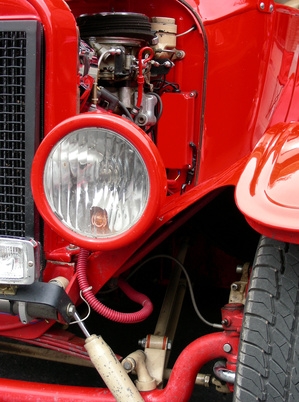
Modern racers have a tendency to marginalize leaf springs as being an obsolete technology, utilized only where the racing organization's rules dictate them. However, a well-engineered leaf spring setup is more than capable of competing with coil spring and four-link designs, especially in real-world conditions where the road surface is less than ideal.
In racing, a suspension's "moment" is the imaginary point around which the entire setup rotates. The moment location of a leaf spring setup can have far-ranging effects on axle wrap, roll tendency and weight transfer in the corners. One tried and true method is to measure the spring eyes' distance from the ground, add them together and divide by two. When you draw a "horizontal" line from one spring eye to the other, the suspension's moment is where your calculated height intersects this line. Generally, if you increase the moment height relative to the spring arch's ground clearance, then you end up with a little more lateral spring twisting but will increase consistency of spring rate by reducing the spring's tendency to go into a negative arch.
If you allow your springs to go into a negative (upward) arch, you'll experience rapid changes in spring rate while it changes shape from one direction to the other. This will result in unpredictable handling and an unforgiving chassis. If your sanctioning body allows it, you might want to consider an adjustable bump-stop like those used for MacPherson strut suspensions. Aftermarket "foam-type" bump stops are very progressive and surprisingly resilient when compressed, and will give your car a much smoother and more predicable breakaway threshold than old-style rubber bump stops.
When well engineered, a leaf spring package can do a better job of preventing lateral movement and axle twist than most types of coil spring setups. One way to help ensure that your leaf spring package always does its job without undue twisting or lateral movement is to use the widest possible spring package. Make sure to get rid of your rubber bushings in favor of metal or polyurethane; otherwise, the springs won't be able to control lateral movement the way they should.
Only use lowering blocks when absolutely necessary. Lowering blocks move your axle's center of rotation closer to the moment, which reduces the axle's ability to wrap under engine torque. This can be a good thing if you're using very long spring that are prone to axle hop but should be avoided in any other case. If you want to lower the car more than 2 inches, invest in a set of new springs or relocate the shackle/spring eye mounts in the chassis.
Spring angle can have a huge effect on your oversteer/understeer balance. Altering angle is a great option if you already have a spring rate/shock setup that works for your conditions, but you need a little more or less rear bite. Generally, lowering the front spring eye or raising the rear will tighten up rear handling, a lower roll center (for increased body roll and side-bite handling) and less body/tire gap during acceleration/deceleration. Raising the front spring eye or lowering the rear will have the opposite effects.